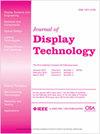从一点亮度轮廓测量确定双视图自动立体显示器的合格空间
Q Engineering
引用次数: 0
摘要
我们引入了一种扩展的评估方法来计算合格空间的水平截面。该方法基于自动立体双视图显示器中心的一点亮度测量。它能够根据人体工程学观点对自动立体双视图显示器进行强大的评估。我们展示了自动立体显示器的观察者的运动自由度如何取决于瞳孔间距离。因此,考虑个体瞳孔间距离来确定新引入的合格立体眼空间。对这些空间的评估以几个参考值和图表的形式对观察员的行动自由度进行了量化。引入的合格眼睛空间的概念与自动立体显示器的当前标准化兼容,并且克服了先前讨论的合格观看空间的概念的局限性。本文章由计算机程序翻译,如有差异,请以英文原文为准。
Determination of Qualified Spaces at Two-View Autostereoscopic Displays From One-Point Luminance Profile Measurements
We introduce an extended evaluation method to calculate the horizontal cross sections of qualified spaces. The method is based on one-point luminance measurements at the center of autostereoscopic two-view displays. It enables a powerful appraisal of autostereoscopic two-view displays with respect to the ergonomic viewpoint. We show how the freedom of movement for the observer of an autostereoscopic display depends on the interpupillary distance. Thus, individual interpupillary distances are considered to determine the new introduced qualified stereoscopic eye spaces. The evaluation of these spaces results in the quantification of the freedom of movement of the observers in the form of several reference values and charts. The introduced concept of qualified eye spaces is compatible with the current standardization of autostereoscopic displays and overcomes the limitations of the previously discussed concept of qualified viewing spaces.
求助全文
通过发布文献求助,成功后即可免费获取论文全文。
去求助
来源期刊

Journal of Display Technology
工程技术-工程:电子与电气
CiteScore
1.50
自引率
0.00%
发文量
0
审稿时长
2.8 months
期刊介绍:
This publication covers the theory, material, design, fabrication, manufacturing and application of information displays and aspects of display technology that emphasize the progress in device engineering, design and simulation, materials, electronics, physics, and reliability aspects of displays and the application of displays. The Journal is sponsored by EDS, seven other IEEE societies (BT, CES, CPMT, IA, IM, PHO and SSC) and the Optical Society of America (OSA).
 求助内容:
求助内容: 应助结果提醒方式:
应助结果提醒方式:


